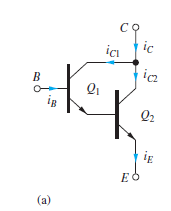
Introductory Circuit Analysis (13th Edition)
13th Edition
ISBN: 9780133923605
Author: Robert L. Boylestad
Publisher: PEARSON
expand_more
expand_more
format_list_bulleted
Question
What are the values of βF , IB, IC1, IC2, Ri B, and RiC for the npn Darlington circuit in as shown if IC = 100μA, βF1 = 40, βF2 = 110, VCE = 6 V and the Early voltages of both transistors are 60 V?

Transcribed Image Text:ic
ici
iв
Q2
(a)
Expert Solution
This question has been solved!
Explore an expertly crafted, step-by-step solution for a thorough understanding of key concepts.
Step by stepSolved in 3 steps with 3 images

Knowledge Booster
Learn more about
Need a deep-dive on the concept behind this application? Look no further. Learn more about this topic, electrical-engineering and related others by exploring similar questions and additional content below.Similar questions
- Please answer in typing format please ASAP for the like please clear the solution of above question is given to Please answer in typing format please ASAP for the like pleasearrow_forwardi need detail explanations on how to solve this questionarrow_forwardHow do I find the voltage gain of this Common Base circuit with two transistors? There is no early voltage.arrow_forward
- 4. A Darlington transistor is essentially an array of two transistors connected as shown below. Assume both transistors follow our simple model with a current gain of B=100. Determine the maximum value of R2 that will just saturate the transistors, and pass full current through the load resistance R1. v2 V2 R2 PULSE (0 5 0) Q2 NPN R1 10 Q1 NPN V1 24arrow_forwardc) Figure 2.3 shows the circuit diagram of a typical npn BJT common emitter amplifier. The values of RB1-30 kOhm, RB2=10.XY kOhm, Rc-3.XY kOhm, Ic=2.XY mA and Vcc=24 V. If the transistor current gain 3 = 50 determine using the full analysis and assuming VBE = 0.7 V the value of RE, hence identify the location of the Q-point (Ic, VCE, IB and VBE). Now sketch the AC circuit model of this amplifier and determine the value of the ac open circuit voltage gain Av and the ac short circuit current gain Ai. (Assume that Vth = 26 mV). Vin RB1 Cin lin RB2 -10 Rc VB RE + Vcc Vc Cout VE www li Figure 2.3 Vout Ce ¡out x=1 y=7arrow_forward
arrow_back_ios
arrow_forward_ios
Recommended textbooks for you
 Introductory Circuit Analysis (13th Edition)Electrical EngineeringISBN:9780133923605Author:Robert L. BoylestadPublisher:PEARSON
Introductory Circuit Analysis (13th Edition)Electrical EngineeringISBN:9780133923605Author:Robert L. BoylestadPublisher:PEARSON Delmar's Standard Textbook Of ElectricityElectrical EngineeringISBN:9781337900348Author:Stephen L. HermanPublisher:Cengage Learning
Delmar's Standard Textbook Of ElectricityElectrical EngineeringISBN:9781337900348Author:Stephen L. HermanPublisher:Cengage Learning Programmable Logic ControllersElectrical EngineeringISBN:9780073373843Author:Frank D. PetruzellaPublisher:McGraw-Hill Education
Programmable Logic ControllersElectrical EngineeringISBN:9780073373843Author:Frank D. PetruzellaPublisher:McGraw-Hill Education Fundamentals of Electric CircuitsElectrical EngineeringISBN:9780078028229Author:Charles K Alexander, Matthew SadikuPublisher:McGraw-Hill Education
Fundamentals of Electric CircuitsElectrical EngineeringISBN:9780078028229Author:Charles K Alexander, Matthew SadikuPublisher:McGraw-Hill Education Electric Circuits. (11th Edition)Electrical EngineeringISBN:9780134746968Author:James W. Nilsson, Susan RiedelPublisher:PEARSON
Electric Circuits. (11th Edition)Electrical EngineeringISBN:9780134746968Author:James W. Nilsson, Susan RiedelPublisher:PEARSON Engineering ElectromagneticsElectrical EngineeringISBN:9780078028151Author:Hayt, William H. (william Hart), Jr, BUCK, John A.Publisher:Mcgraw-hill Education,
Engineering ElectromagneticsElectrical EngineeringISBN:9780078028151Author:Hayt, William H. (william Hart), Jr, BUCK, John A.Publisher:Mcgraw-hill Education,

Introductory Circuit Analysis (13th Edition)
Electrical Engineering
ISBN:9780133923605
Author:Robert L. Boylestad
Publisher:PEARSON

Delmar's Standard Textbook Of Electricity
Electrical Engineering
ISBN:9781337900348
Author:Stephen L. Herman
Publisher:Cengage Learning

Programmable Logic Controllers
Electrical Engineering
ISBN:9780073373843
Author:Frank D. Petruzella
Publisher:McGraw-Hill Education

Fundamentals of Electric Circuits
Electrical Engineering
ISBN:9780078028229
Author:Charles K Alexander, Matthew Sadiku
Publisher:McGraw-Hill Education

Electric Circuits. (11th Edition)
Electrical Engineering
ISBN:9780134746968
Author:James W. Nilsson, Susan Riedel
Publisher:PEARSON

Engineering Electromagnetics
Electrical Engineering
ISBN:9780078028151
Author:Hayt, William H. (william Hart), Jr, BUCK, John A.
Publisher:Mcgraw-hill Education,